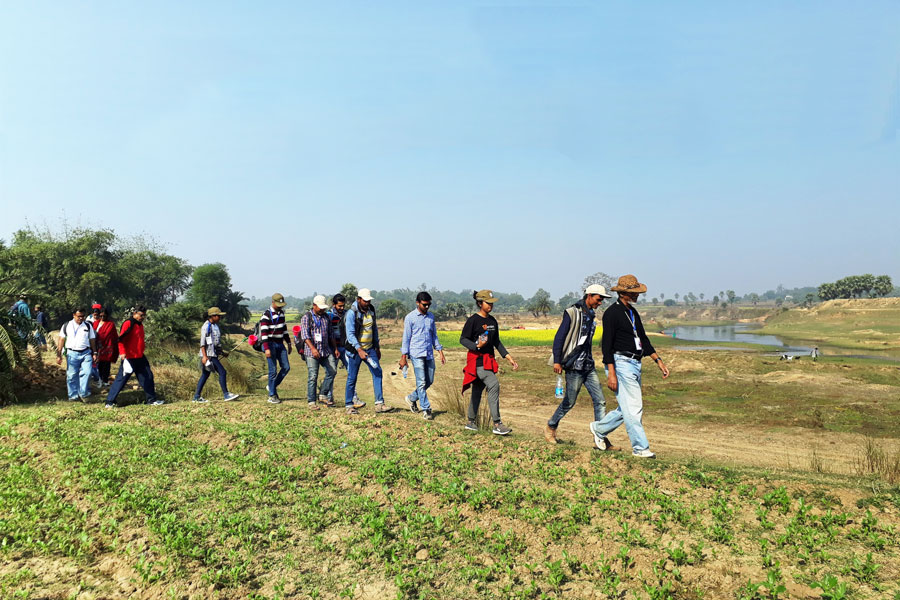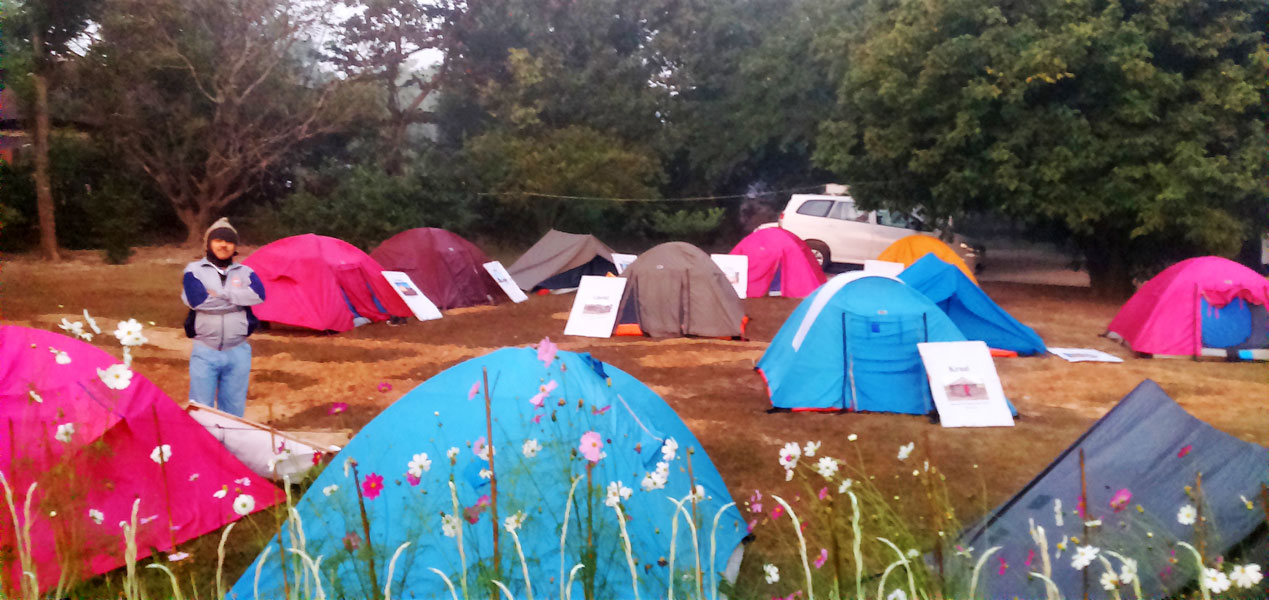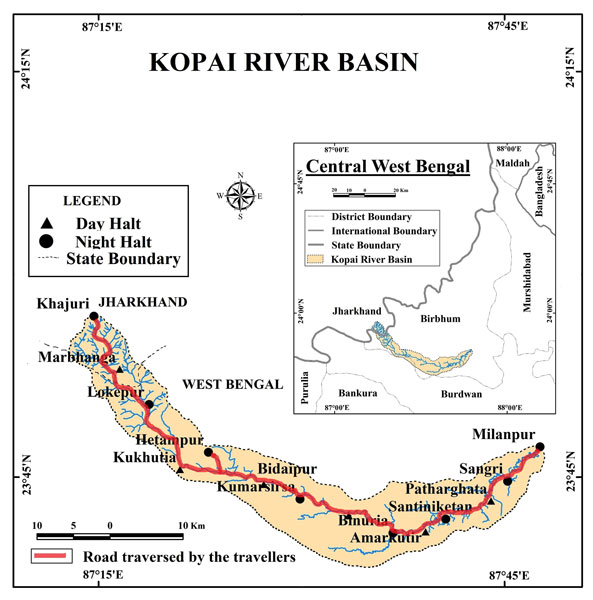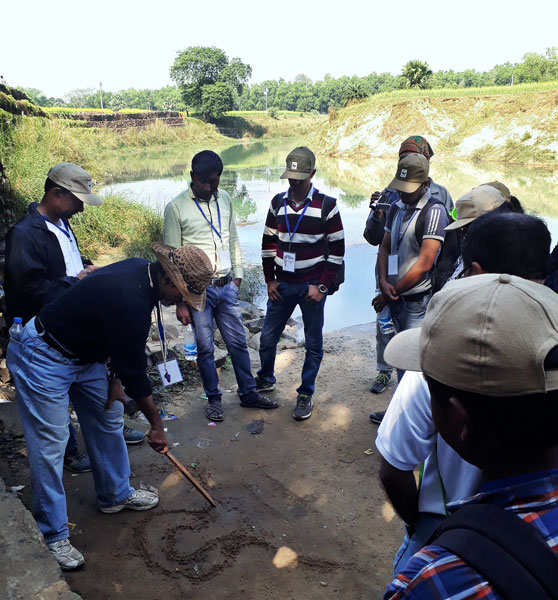Honouring River Kopai

Prof Malay Mukhopadhyay is a passionate potamologist (one who is an expert on rivers and researches rivers). A professor of Geography at the Visva Bharati University, he has trekked along five rivers, including River Thames in London, to raise consciousness about the importance of rivers in our lives and how people living around these rivers should take care of them. In December 2017, after intensive research, aided by his research scholars, he headed a 40-day 110 km-long trekking expedition along the Kopai river.
Whichever village we visited, we got such warm hospitality that it felt like the villagers were celebrating some kind of a festival. They brought us tea, food and tried their best to help us if we had any problem.
“He looks at rivers as living embodiments and any harm done to them is painful to him. He is a charter member of our club RC Tagore Land, which is nestled in the bosom of Santiniketan, the abode of peace where Nobel laureate Rabindranath Tagore started the Visva Bharati University. The club has many professors from the university as its members, and he undertook this unique project to focus people’s attention on the degradation of rivers,” says PDG Ashok Kumar Agarwal from RID 3240.
Under the professor’s leadership, some of his club members, colleagues and students and some German visitors undertook a week-long expedition to trek from the source of the Kopai River to its confluence with the Mayurakshi River, a distance of 110 km. Kopai is a small river flowing in the north of Santiniketan, originating from the foothills of the Chotanagpur plateau in the west and flows east ultimately to surrender its identity to the Mayurakshi River.
On why he chose the Kopai River, Prof Mukhopadhyay said that the great poet Tagore was very fond of this river. “It was he who changed its name to the present Kopai because it was prone to flooding and people were very scared of the floods. But it also had a lot of water for irrigation and the local people conducted a lot of rituals at this river.”
Some villagers remembered that many years earlier a professor had installed a stone to celebrate the river. They couldn’t recognise him but the professor was thrilled and said it meant that such efforts to preserve our natural resources do not go unnoticed.
In fact, so enamoured was Tagore with the Kopai River that he wrote about it: “Amader chhoto nodi chale anke bankey, Boisakh masey taar hantu jal thakey (Our small stream moves forward in bends and curves In the month of Baisakh it only has knee-deep waters).”
Another reason for Tagore’s enchantment was the scenic beauty of this river and he had invited the famous potamologist Dr Arthur Gedes to study this river. “When I joined the Visva Bharati University some 30 years ago, I started researching the river and sometime later trekked along this river with my wife and daughter Gayatri, who was then only 3 years old, and her name is there in the Guinness Book of World Records,” says the professor.
The trek
Explaining the organisation of the trek, Sanjukta Banik, Prof Mukhopadhyay’s research scholar, said the trek had about 40 permanent members, of whom half a dozen were women, who trekked the entire 110 km distance. There were seven German associates of the professor who also joined the expedition. Others joined it at different points for a journey of a day or two and there were about 15 to 20 women in this category. During this 8-day trek, which was very flexible for its participants, the group stayed in tents on or near the banks of the river near eight different villages and tried to make the villagers aware of the importance of keeping the river clean and alive.

Describing the trek and the participation of women as well as the challenges the trekkers faced, she said that the major challenge was that each day a distance of 30 km had to be covered and “we had participants aged from 4 to 82 years. From my point of view this was the biggest challenge; the 82-year-old was Professor Mukhopadhyay’s elder brother.”
At night the trekking group halted in villages in makeshift tents, “and we slept in sleeping bags.” For their toilet needs the women didn’t face much of a problem “because in most places we pitched our tents on school grounds and used their toilets. Sleeping in schools also provided us the safety feature,” she added.
An integral objective of this trek was to identity some tourist and heritage points along the river — small temples and other tourist spots of historic or cultural value.
Prof Mukhopadhyay said one night was spent on the campus of their Rotary club, where some 13 tents were pitched.
The group put a marker stone at the source of this river in the village called Khajuri. This marker stone has Rotary’s emblem prominently displayed. “The trek not only created awareness among the different villagers about the importance of river in our lives but also how to save it from degradation. It also created ripples in the minds of Rotarians who trekked along its path as how human greed is destroying our environment and what nature has gifted us,” says Prof Mukhopadhyay. On his invitation some Germans from the NGO Indian Helfie also joined the trek.
Warm reception
Sanjukta adds that the team was overwhelmed by the reception they got from the villagers. “That was the best part; whichever village we visited, we got such warm hospitality that it felt like the villagers were celebrating some kind of a festival. They brought us tea, food and tried their best to help us if we had any problems.”
But then quite a few members of the team were familiar with the villagers because about six months before doing this project, Prof Mukhopadhyay and a few of his students, including Sanjukta, had done a recce survey along the river, “visiting all the villages and marking our stops for day and night halts and interacted with the villagers to know their perception about the river,” she adds.
On why this particular river was chosen for the trek and if it was dying, she says, “Not really; Kopai is a very unusual and small river, being only 110 km long. This river was chosen because our professor had conducted a trek along this river 25 years ago in 1991; 2017 was the silver jubilee of that trek so he wanted to honour the river by walking along it with a group of people.”
Asked if there was enough water in the river, she says that parts of it have totally dried; and there are some malpractices which are being carried out at some points. “For example, near Santiniketan, we found that people are concreting the entire river bed.”
Women’s perception
An interesting insight this PhD scholar shares is that the women’s perception and attitude towards the river is quite different from that of men. One part of her assignment was to do a research survey on the village women’s perception about rivers.
“I found from the women that earlier the Kopai River was a part and parcel of the entire village’s life. But now the villagers are moving away from the river. They are no longer dependent on the river and visit it only once or twice a year for some religious purpose or a ceremony. Apart from that, they have no other attachment with the river which is very sad.”

Also, she found that near the source of the river people are totally away or detached from the river; “but as you go along the flow of the river, their attachment increases, but even then it is meagre compared to what it once used to be.” Talking to villagers, she also found that women are more emotionally attached to the river than men. “The men are very happy because they get 100 days’ work from MNREGA and similar schemes to lift sand from the river bed or some construction work and it doesn’t bother them much that the river is dying or drying out. But on the other hand, I found that women really feel sad about the dwindling of the rivers. They were telling us stories from their childhood on how the river used to flow with its full might and how now parts of it have dried out. Women definitely have more feeling toward the river… .”
High point
A high point of the trip for this group of river aficionados was reaching the point where Prof Mukhopadhyay had installed a marker stone 25 years ago, just as he had seen being done at River Thames. “This is a stone which recognises the source of the river at a particular point in Jharkhand and when we reached that point we were all very excited to meet some villagers who remembered that many years ago — 25 to be exact — a professor had come and installed such a stone to celebrate the river. They couldn’t recognise him of course, but the professor was thrilled that even after 25 years his trip was remembered, which meant that such efforts to preserve our natural resources do not go unnoticed,” said Sanjukta.

Prof Mukhopadhyay said an integral objective of this trek was also to identify some tourist and heritage points along the river — small temples and other tourist spots of historic or cultural value — which have been listed and a report is now being sent to INTACH, which had sponsored some parts of the journey.
Next on his agenda is trekking alongside River Ajay and that too will mark the silver jubilee of this potamologist’s return to that river.


